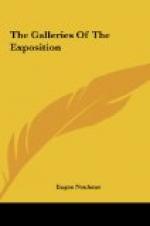Gallery 60.
Our historical section is largely a mausoleum of portraits which really have no other excuse for existence than historical interest, unless one excepts the always excellent portraits of Gilbert Stuart, who certainly stands out in all that dull company of his fellow-painters of his own time. He is about the only one who can claim professional standards of workmanship as well as lifelike characterization of his sitters. His group of pictures on wall A does his great talent full justice. The mellow richness of the portrait of General Dearborn stands out as a fine painting among the many hard and black historical documents in this gallery. The Captain Anthony portrait above is not less important. I think his technical superiority and breadth of manner must be doubly appreciated when one considers the absence of any artistic inspiration in this country in Stuart’s time, although he had the advantage of several lengthy visits abroad, where he was received with approval by profession and public alike. Most other portraits in this gallery are lacking in any individual note and are hopelessly stiff and academic in colour. Not even the very apparent influence of the great English portrait masters of their time could save them from mediocrity. The only pictures worth excepting from this classification, outside of the Stuarts, are Charles Elliott’s “Colonel McKenney” and S. B. Waugh’s portrait of Thorwaldsen, the Danish sculptor.
Gallery 59.
In an adjoining gallery toward the north, our chronological investigations bring us into an atmosphere of story-telling pictures of the most pronounced Düsseldorf and Munich styles. This period has always been the source of delight to the populace, which has no concern in the technical qualities of a picture, a contention which led, more than anything else, to the healthy reaction we now enjoy as the modern school. The sentimental tone of most of these pictures and their self-explanatory illustrative motives no doubt make them easily the lazy man’s delight, but I cannot help feeling that most of their themes could much more successfully be approached through literature than through the painter’s art. Most of them explain themselves immediately, and those which do not are helped along by descriptive titles fastened to the frames, as the taste of that school demands. The great men of this school in Germany were primarily great painters. Men like Defregger, Knaus, Vautier, Grützner, Kaulbach, and others will always command high respect by their technical achievements, no matter how we may disagree with their choice of subjects. The really worthy ones we have produced in this field of genre painting are to be found in other galleries and are represented by men like Hovenden, Currier, and Johnson. The only real painting among the many figure pictures in this gallery is Peter Frederick Rothermel’s “Martyrdom of St. Agnes.” Very rich in colour and big in composition, it compels great respect.




